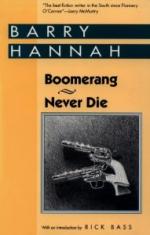|
This section contains 174 words (approx. 1 page at 300 words per page) |
There is no agreement on who first invented the boomerang. Many scientists believe that boomerangs were created independently by a number of prehistoric hunting peoples because they have been found at ancient sites in Africa, Asia, Europe, Indonesia, and North America. However, the boomerang is associated most closely with the Aborigines, the original people of Australia, who use them for hunting and warfare. The boomerang is usually made from hardwood and shaped into a simple curve. It is flat on one side and convex on the other, much like airplane wings, so that it can fly far. The ones most people are familiar with, the returning boomerangs, are generally used more for sport because they are difficult to aim and catch. The nonreturning variety have less of a curve and are used more for hunting or warfare, since their spinning action causes a greater impact than that of a thrown rock or stick. A nonreturning boomerang is capable of nearly piercing a small animal in two from a distance of 400 feet (122 m).
|
This section contains 174 words (approx. 1 page at 300 words per page) |


